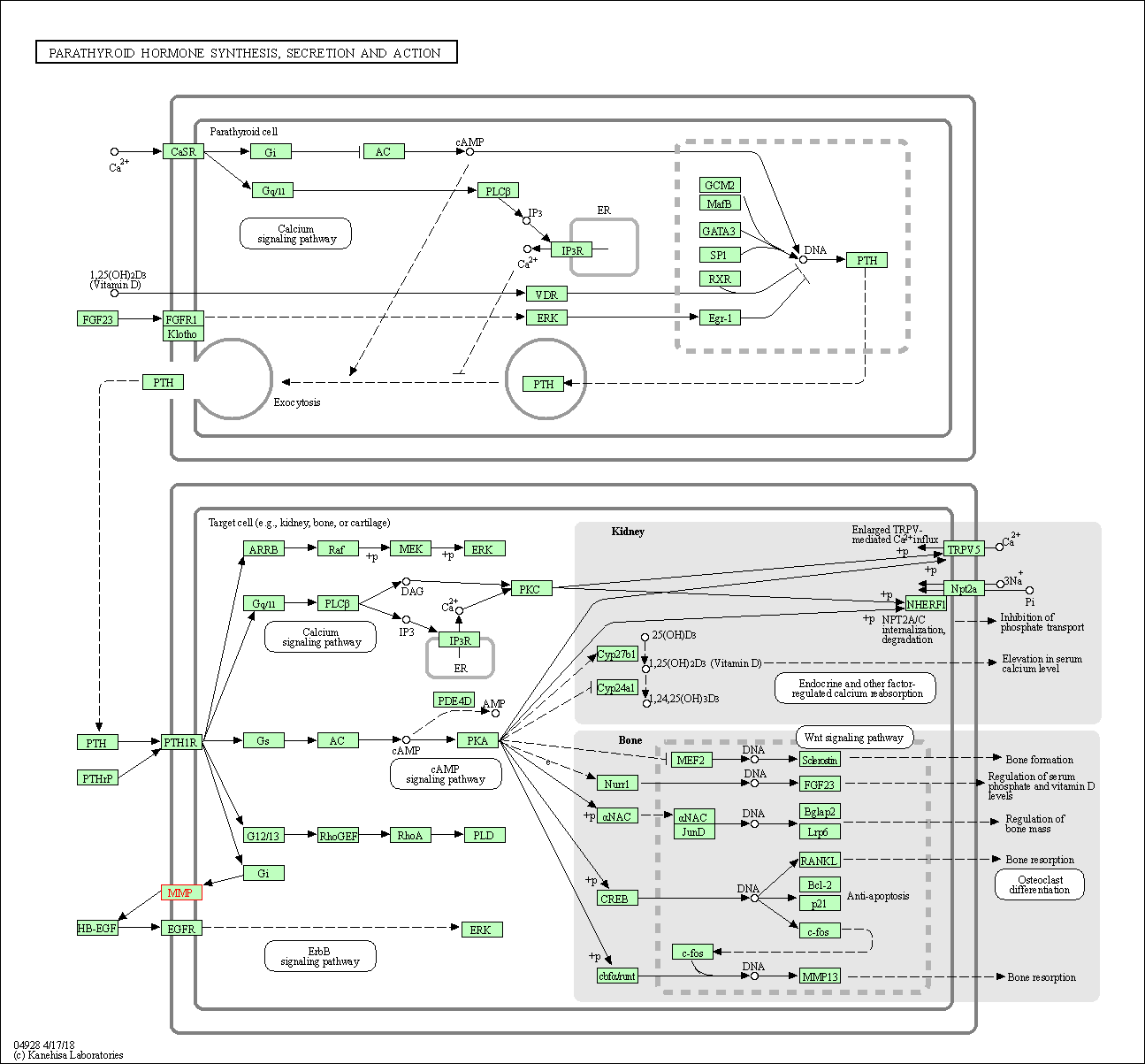Target Information
| Target General Information | Top | |||||
|---|---|---|---|---|---|---|
| Target ID |
T55616
(Former ID: TTDR00072)
|
|||||
| Target Name |
Matrix metalloproteinase-17 (MMP17)
|
|||||
| Synonyms |
Membrane-type-4 matrix metalloproteinase; Membrane-type matrix metalloproteinase 4; MTMMP4; MT4MMP; MT4-MMP; MT-MMP 4; MMP-17
Click to Show/Hide
|
|||||
| Gene Name |
MMP17
|
|||||
| Target Type |
Literature-reported target
|
[1] | ||||
| Function |
Endopeptidase that degrades various components of the extracellular matrix, such as fibrin. May be involved in the activation of membrane-bound precursors of growth factors or inflammatory mediators, such as tumor necrosis factor-alpha. May also be involved in tumoral process. Cleaves pro-TNF-alpha at the '74-Ala-|-Gln-75' site. Not obvious if able to proteolytically activate progelatinase A. Does not hydrolyze collagen types I, II, III, IV and V, gelatin, fibronectin, laminin, decorin nor alpha1-antitrypsin.
Click to Show/Hide
|
|||||
| BioChemical Class |
Peptidase
|
|||||
| UniProt ID | ||||||
| EC Number |
EC 3.4.24.-
|
|||||
| Sequence |
MRRRAARGPGPPPPGPGLSRLPLPLLLLLALGTRGGCAAPAPAPRAEDLSLGVEWLSRFG
YLPPADPTTGQLQTQEELSKAITAMQQFGGLEATGILDEATLALMKTPRCSLPDLPVLTQ ARRRRQAPAPTKWNKRNLSWRVRTFPRDSPLGHDTVRALMYYALKVWSDIAPLNFHEVAG SAADIQIDFSKADHNDGYPFDGPGGTVAHAFFPGHHHTAGDTHFDDDEAWTFRSSDAHGM DLFAVAVHEFGHAIGLSHVAAAHSIMRPYYQGPVGDPLRYGLPYEDKVRVWQLYGVRESV SPTAQPEEPPLLPEPPDNRSSAPPRKDVPHRCSTHFDAVAQIRGEAFFFKGKYFWRLTRD RHLVSLQPAQMHRFWRGLPLHLDSVDAVYERTSDHKIVFFKGDRYWVFKDNNVEEGYPRP VSDFSLPPGGIDAAFSWAHNDRTYFFKDQLYWRYDDHTRHMDPGYPAQSPLWRGVPSTLD DAMRWSDGASYFFRGQEYWKVLDGELEVAPGYPQSTARDWLVCGDSQADGSVAAGVDAAE GPRAPPGQHDQSRSEDGYEVCSCTSGASSPPGAPGPLVAATMLLLLPPLSPGALWTAAQA LTL Click to Show/Hide
|
|||||
| 3D Structure | Click to Show 3D Structure of This Target | AlphaFold | ||||
| Cell-based Target Expression Variations | Top | |||||
|---|---|---|---|---|---|---|
| Cell-based Target Expression Variations | ||||||
| Different Human System Profiles of Target | Top |
|---|---|
|
Human Similarity Proteins
of target is determined by comparing the sequence similarity of all human proteins with the target based on BLAST. The similarity proteins for a target are defined as the proteins with E-value < 0.005 and outside the protein families of the target.
A target that has fewer human similarity proteins outside its family is commonly regarded to possess a greater capacity to avoid undesired interactions and thus increase the possibility of finding successful drugs
(Brief Bioinform, 21: 649-662, 2020).
Human Pathway Affiliation
of target is determined by the life-essential pathways provided on KEGG database. The target-affiliated pathways were defined based on the following two criteria (a) the pathways of the studied target should be life-essential for both healthy individuals and patients, and (b) the studied target should occupy an upstream position in the pathways and therefore had the ability to regulate biological function.
Targets involved in a fewer pathways have greater likelihood to be successfully developed, while those associated with more human pathways increase the chance of undesirable interferences with other human processes
(Pharmacol Rev, 58: 259-279, 2006).
Human Similarity Proteins
Human Pathway Affiliation
|
|
|
There is no similarity protein (E value < 0.005) for this target
|
| KEGG Pathway | Pathway ID | Affiliated Target | Pathway Map |
|---|---|---|---|
| Parathyroid hormone synthesis, secretion and action | hsa04928 | Affiliated Target |

|
| Class: Organismal Systems => Endocrine system | Pathway Hierarchy | ||
| Chemical Structure based Activity Landscape of Target | Top |
|---|---|
| Target Poor or Non Binders | Top | |||||
|---|---|---|---|---|---|---|
| Target Poor or Non Binders | ||||||
| References | Top | |||||
|---|---|---|---|---|---|---|
| REF 1 | Drugs, their targets and the nature and number of drug targets. Nat Rev Drug Discov. 2006 Oct;5(10):821-34. | |||||
If You Find Any Error in Data or Bug in Web Service, Please Kindly Report It to Dr. Zhou and Dr. Zhang.

